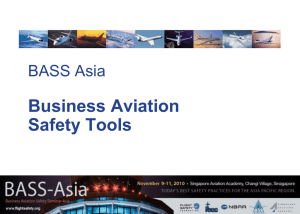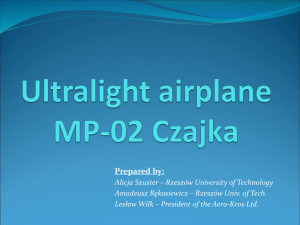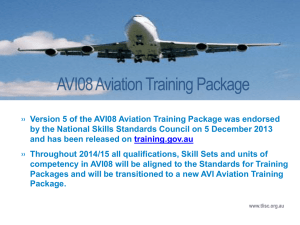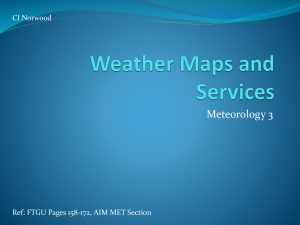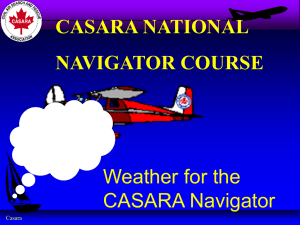SECTION 1,2 AVIATION WX SERVICE PROGRAM
advertisement
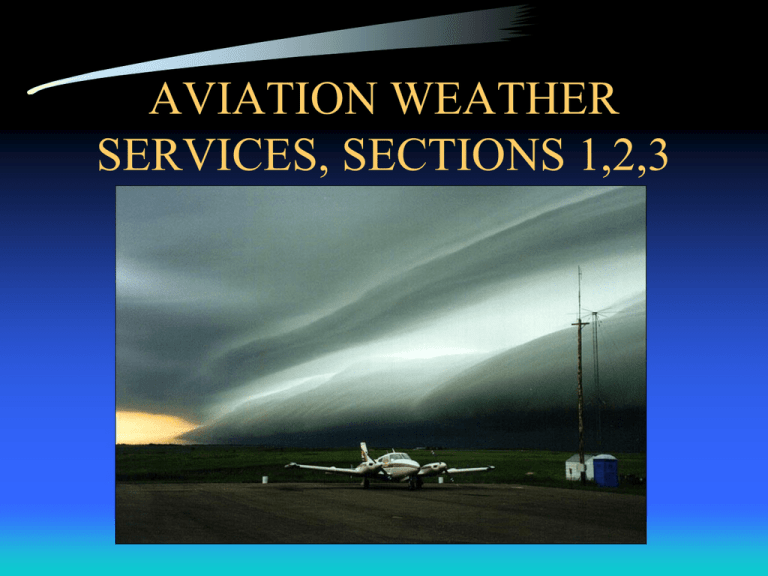
AVIATION WEATHER SERVICES, SECTIONS 1,2,3 HOMEWORK • Read sections 1, 2 & 3 out of the Aviation Weather Services AC 00-45G • Get a TIBS briefing • Get a standard VFR weather briefing for a flight from MWH to ELN (does not need to be turned it) • Turn in on Tuesday the A Pilot’s Guide to Flight Service (AOPA interactive course) AC 00-45G ONLINE LINKS • Book can be found in the bookstore or online off the www.faa.gov website in the AC directory. • http://rgl.faa.gov/Regulatory_and_Guidance_L ibrary/rgAdvisoryCircular.nsf/0/6a07efaa9a68 c1a8862576c70052e9e5/$FILE/AC-0045G.pdf • http://rgl.faa.gov/Regulatory_and_Guidance_L ibrary/rgAdvisoryCircular.nsf/MainFrame?Op enFrameSet SECTION 1 AVIATION WX SERVICE PROGRAM • • • • 3 sources for aviation weather 1. National Wx Service NWS 2. Department of Defense DOD 3. Federal Aviation Administration FAA NOAA • National Oceanic and Atmospheric Administration NOAA • Conducts research and gathers data about the global oceans, atmosphere, space, and sun, and applies this knowledge to science and service which touch the lives of all Americans • Among the 6 major divisions are the National Environmental Satellite Data and Information Service (NESDIS) and the NWS National Wx Service NWS • Collects and analyzes meteorological and hydrological data and prepares forecasts on a national, hemispheric, and global scale. • Provides weather data, forecasts and warnings National Wx Service NWS • NWS has nine separate national centers under the National Centers for Environmental Prediction (NCEP) each with its own mission. • NCEP is where virtually all global meteorological data is collected and analyzed National Wx Service NWS • NWS nine missions are: • Climate Prediction Center, Space Environment Center, Marine Prediction Center, Hydrometeorlogical Prediction center, Enviromental Modeling Center, NCEP Center Operations, Strom Prediction Center, Aviation Weather Center, and the Tropical Prediction Center AVIATION WEATHER CENTER (AWC) • Located in Kansas City • Issues warnings, forecasts, and analyses of hazardous weather for aviation interests. • Identifies existing or imminent weather hazards to aircraft in flight and creates warnings for transmission to the aviation community. • Forecasts of wx expected during the next 2 days that will affect domestic and international aviation interests. AVIATION WEATHER CENTER (AWC) • Produce (FA’s) Area forecasts, in-flight weather advisories (AIRMET) Airman’s Meteorological Information, Significant Meteorological Information (SIGMET), and Convective SIGMETs) for the contiguous 48 states, Significant Weather Prog Charts (low, middle, and high), Collaborative Convective Forecast Product, National Convective Weather Forecast, Current Icing Product, and Forecast Icing Potential. WEATHER FORECAST OFFICE (WFO) NWS • Issues various public and aviation forecast and weather warnings. • Issue (TAFs) Terminal Aviation Forecasts and (TWEBs) Transcribed weather broadcasts. Some issue Airport Weather Warnings, and Soaring Forecasts • In Guam and Hawaii also issue FA’s AIRMETS AND SIGMETS and route forecasts. WEATHER FORECAST OFFICE (WFO) • In Alaska the Alaskan Weather Unit (AAWU) issues its own international SIGMET and domestic FAs and AIRMETs FAA • In control of the (FSSs) Flight Service Stations • Trying to modernize all to an Automated FSS with about one per state. Are referred to as “hub” facilities. • Provide more aviation weather service than any other government outlet. FSS • Provide preflight and in-flight briefings, transcribed weather briefings, scheduled and unscheduled weather broadcasts, and furnishes weather support to flight in its areas Constantly changing adding and removing products • TWEB REMOVED ON AC 00-45G • http://www.wrh.noaa.gov/byz/local_news/20 07/tweb.php TWEB (route forecast) • Provides continuous aeronautical and meteorological information on low/medium frequency (L/MF) and very high frequency (VHF) omni-directional radio range (VOR) facilities. • Can also be an NDB TRANSCRIBED WEATHER BROADCAST (TWEB) • OUTDATED NO LONGER PROVIDE • Content = 11 items • Introduction., Synopsis., Adverse Conditions., TWEB Route Forecast., Winds Aloft for levels 3,000-12,000., Radar Report., METARs., Density Altitude, PIREPs, Alert Notices, Closing Statement. (T in Nav Box on Sectional) • Pilots’ automatic telephone weather answering system (PATWAS) also recently removed SAFETY/Briefings • The pilot is responsible for ensuring he/she has all the information needed to make a safe flight. • How can you do this? • www.duat.com , www.duats.com or 1-800wx brief GETTING A BRIEFING • To provide an appropriate weather briefing, specialists need to know which of the three types of briefings is needed – a standard, abbreviated or outlook. Other helpful information is whether the flight will be conducted VFR or IFR, aircraft identification and type, departure points, estimated time of departure, flight altitude, route of flight, destination, and estimated time en route. BRIEFINGS • #1 VFR or IFR / Standard, Abbreviated, or Outlook briefing • #2 Aircraft number or pilot’s last name • #3. Aircraft type • #4. Departure point • #5. Route of flight • #6. Destination • #7 Flight altitudes • #8 ETD and ETE Types of weather briefings • Standard briefing includes everything • Abbreviated briefing - used to supplement information you already have • Outlook briefing - when the briefing is 6 hours or more in advance of proposed departure WX BRIEFING • • • • • • • • 3 types: Standard, Abbreviated, Outlook 1. Standard When the full wx picture is desired What you get and what order: Adverse conditions VFR flight not recommended Weather synopsis Current Wx WX BRIEFING • • • • • • En Route Forecast Destination Forecast Forecast winds temp aloft NOTAMs ATC delays Other info Request for PIREPS EFAS WX BRIEFING • • • • • 2. Abbreviated User must request Questions about reports and so forth Designed to supplement an earlier briefing Request specific info WX BRIEFING • 3. Outlook • Provided when departure is 6 hours or more in the future • Very general DUATS • http://www.duats.com/ • http://www.duat.com/ • You all should have a code!!! TELEPHONE INFORMATION BRIEFING SERVICE (TIBS) • Is provided by AFSSs and provides continuous telephone recordings of meteorological and/or aeronautical information. TIBS shall contain area and or route briefings, airspace procedures, and special announcements, if applicable • Should also contain METARs, TAFs and winds aloft (normally a feature with 1-800 wx brief (say TIBS instead of briefer) • CAN ALSO CALL 1-877-4TIBS-WX (1-877-4842799) • Eastern WA press 12 • Events WA 19 • AFD PAGE 235 TELEPHONE INFORMATION BRIEFING SERVICE (TIBS) • Provides at least 4 route and/ or area briefings. Should also encompass a 50 NM radius. • Provided 24 hours a day. • Recordings are updated as conditions change. Or when ever the material is updated. • DOES NOT CONSTITUDE A BRIEFING TIBS • Include = 13 items • Introduction, Adverse conditions, VFR not recommended, Synopsis, Current conditions, Density Altitude, En route forecast, winds aloft, request for PIREPs, NOTAM info, Military Training activity, Alert Announcement, closing statement • Airport Facility Directory lists TIBS telephone numbers for AFSS briefings. A touch tone phone is necessary to access. All usually now can be access with 1-800 wx brief • 1-877-4TIBS-WX (1-877-484-2799) HIWAS • Hazardous Inflight Weather Advisory Service (HIWAS) • continuous broadcast of inflight weather advisories such as SIGMETs, AIRMETs, and urgent PIREPs • broadcast over a defined area within 150 NM of HIWAS outlets. 24 hours a day • An announcement will be made if there are no hazardous weather advisories. HIWAS • The broadcast includes • A statement of introduction including the appropriate areas and recording time • A summary of inflight weather advisories • A request for PIREPs • A recommendation to contact AFSS/FSS/FLIGHT WATCH for additional details concerning the hazardous weather. HIWAS • Once a HIWAS broadcast is updated, an announcement will be made once on all communication/NAVAID frequencies except emergency, and EN Route Flight Advisory Service. • Look on your sectional NAVAIDs EFAS • En Route Flight Advisory Service (EFAS) also known as flight watch. • Common frequency 122.0 mHz below flight level FL180 and on assigned discrete frequencies to aircraft at FL180 and above. • Purpose is to provide en route aircraft with timely and pertinent weather data tailored to a specific altitude and route using the most current available sources of aviation wx info. DELAYS • WEATHER IS THE MOST COMMON REASON FOR AIR TRAFFIC DELAYS AND RE-ROUTINGS. • En route controls shall advise pilots of hazardous weather that may impact operations within 150 NM of the controller’s assigned sector or area of jurisdiction. Aviation Weather Reports and Forecasts • Already in flight HIWAS (hazardous inflight weather advisory service, over VOR’s Airmets/Sigmets) • EFAS (enroute flight advisory service, or flight watch, 122.0 mHz)enroute weather PIREPS • Radio, Television, Internet, ATIS, Tower, DUATS etc.. WX from ATC • Everything is Magnetic. • Time in Zulu OBSERVATIONS • Surface observations - existing conditions, when recorded and transmitted the observation becomes a report, and the reports are the basis of all weather analyses, forecasts, advisories, and briefings. OBSERVATIONS • Observations include: • METARs, FDs, PIREPs, SDs, Low Level Wind Shear Alert Systems, Satellite Imagery OBSERVATIONS • Upper air observations –radiosonde balloons, PIREPS • temp, humidity, pressure, wind –PIREPS are the only way to get info on icing, cloud layers, turbulence, flight visibility OBSERVATIONS • Radar observations – ARTCC and NWS NEXRAD – TDWR terminal display wx radar (wind shear, gusts, heavy precip) – RRWDS radar remote wx display system (being replaced by Doppler) OBSERVATIONS • Low Level Wind Shear Alert System • real time computerized system • compares wind sensors around outside to one in the middle • warning issued on ATIS or upon initial call up OBSERVATIONS • Satellite observations • visible and infrared • near real time info to NWS and FAA SECTION 2 • Classification of weather products • Primary (sections 3-8) is an aviation product that meets all the regulatory requirements and safety needs for the use in making weatherrelated flight decisions • Supplementary Weather Products (Section 9) may be used to enhance situational awareness. • Enhanced Weather Information System (page 2-3) METAR SECTION 3 • METAR= Meteorological Aviation Routine weather report • In 1996 US converted to the ICAO and the World Meterological Organization form of aviation weather reporting. • Each country is allowed to make modifications to the code to use in that particular country • In the U.S. visibility is in statute miles, runway visual range in feet, wind speed in knots, and altimeter setting in inches of mercury METAR • Elements of a METAR • 1. Type of Report • 2. ICAO station identifier • 3. Date and time of report • 4. Modifier (as required) • • • • • • • • 5. Wind 6. Visibility 7. RVR 8. Weather 9. Sky conditions 10. Temp/DPT 11. Altimeter 12. Remarks METAR FORMAT METAR FORMAT Type of Report • • • • Either METAR or SPECI METAR=Aviation Routine Weather Report SPECI=Selected Special Weather Report METAR’s are issued normally 5-10minutes before the hour every hour • METAR’s are reports (a moment of time) not a forecast SPECI STATION IDENTIFIER • ICAO codes 4 letters IDENTS YOU SHOULD KNOW • • • • • • • • • • KMWH = MOSES LAKE GRANT COUNTY INT’L KEPH = EPHRATA KEAT = WENATCHEE PANGBORN MEMORIAL KELN = ELLENSBURG BOWERS FIELD KYKM = YAKIMA KPSC = PASCO KGEG = SPOKANE INT’L KOMK = OMAK KALW = WALA WALA http://en.wikipedia.org/wiki/List_of_airports_by_ICAO_code:_A • http://www.faa.gov/airports_airtraffic/air_traffic/publications/atpubs/LID/LIDHME .htm METAR IDENTIFIERS • 4 letter identifiers (ICAO) • In the conerminous U.S. prefixed with a K • Alaska, Hawaii, and the Mariana Islands start with a P followed by an A, H, or G respectively • Example ANC (anchorage) PANC METAR IDENTIFIERS • Example OME (NOME) PAOM • HNL (honolulu) becomes PHNL • UAM (anderson, Guam) becomes PGUA • In Canada prefixed by a C • Mexico M • Eastern Caribbean T, South America S DATE AND TIME • 011955Z = 1ST TWO DIGITS DAY OF MONTH OR IT IS THE 1ST OF THE MONTH • 1955Z = TIME OF THE REPORT OR 1955 ZULU OR UTC REPORT MODIFIER • AUTO = fully automated report with no human intervention (here when the tower is in operation you normally do not see the AUTO) • COR = METAR or SPECI was corrected • If AUTO is shown in the report, AO1 and A02 will be encoded in the remarks section of the report to indicate the type of precipitation senso used at the station. MODIFIER • A01-Automated station with out precipitation discrimination • A02- with precip discrimination • Modifier COR identifies a corrected report that is sent out to replace an earlier report with an error. WIND GROUP • 22015G25KT = Wind from 220 degrees true at 15 gusting 25 knots WIND • Reported as a 5 digit group (6 digits if speed is over 99 knots) • 1st three digits are the wind direction from which the wind is blowing in tens of degrees from TRUE north. Directions less than 100 degrees are proceeded with a zero WIND WIND • Wind Remarks • If the facility has a wind recorder and the wind peak exceeds 25 knots PK WND will be included in the remarks element of the next report. • 1st 3 digits for direction and two or three for speed. If the hour can be inferred from the report time will be in minutes only. PK WND 28045/15 WIND Shift/ Visibility • • • • • • WSHFT 30 FROPA 45 degrees in less than 15 minutes Wind Shift/Frontal Passage Visibility in statute miles 1 1/2SM, 3 SM When visibility is less than 7 SM the restriction to visibility will be shown in the weather element. VISIBILITY Automated reporting stations will show visibility less than 1/4 statute miles as M1/4SM and visibility 10 or greater than 10 statute miles as 10SM OBSCURATIONS • BR = Mist restricting vis and is used only when the visibilty is from 5/8 mile to 6 miles. • FG= Fog visibility less than 5/8 • Other items you can find in the weather phenomena are: • SQ=sudden increase in wind speed of at least 16 knots rising to above 22 RVR RVR 5000ft=1, 2400ft=1/2 mile PRESENT WEATHER GROUP OTHER • +FC=tornado or waterspout • FC=is used to denote a funnel cloud SKY CONDITION SKY CONDITION • Cloud bases are reported with three digits in hundreds of feet above ground level. Example • SCT020 • Clouds above 12,000 feet cannot be detected by automated reporting systems shown as (///) • SCT/// Ceiling is BKN, OVC, or VV • if ceiling is variable CIG 005V010 SKY COVER TEMP/DPT & Altimeter • In degrees C • Sub-zero temps and dew points are prefixed with an M • Altimeter starts with an A and is in inches of mercury. REMARKS WEATHER BEGINS/ENDS • RAB05E30SNB30E45 ALTIMETER • Altimeter Remarks • PRESRR or PRESFR • SLP982 in hectopascals or millibar. SLPNO sea-level pressure not available METAR • METAR KGNV 201933Z COR 24015KT 3/4SM R28/2400FT +TSRA BKN008 OVC015CB 26/25 A2985 RMK TSB32RAB32 • METAR KPIT 091955Z COR 22015G25KT 3/4SM R28L/2600FT TSRA OVC010CB 18/16 A2992 RMK SLP045 T01820159 FMH-1 • http://www.ofcm.gov/fmh-1/pdf/LCH12.pdf METAR • METAR KMWH 231852Z 00000KT 5SM BR OVC004 03/02 A2998 RMK AO2 UPE1753B15E24 SLP161 P0000 T00280022
